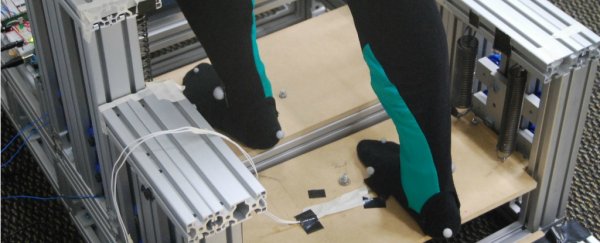Climbing up and down flights of stairs is about to get a whole lot easier for people suffering from joint pain. Researchers have built energy-recycling steps that store energy as you walk down while giving you a boost when you walk up.
The smart stairs lower the impact on knees and ankles thanks to built-in springs and pressure sensors. The interactive steps could be a low-cost, energy-efficient alternative to expensive stair lifts and elevators.
"Walking down stairs is like tapping the brakes of your car while revving the engine," says one of the researchers, Lena Ting from Georgia Institute of Technology.
"Your legs use a lot of energy bracing each step to avoid falling too fast. Our stairs store that energy rather than wasting it."
Compared to walking on flat ground, using stairs is three times more demanding on our knees. It's even more challenging for people suffering from joint pain, muscle weakness and reduced sensorimotor control, and is one of the top five most difficult tasks for older people.
Although elevators and stair lifts are already helping the elderly and disabled people conquer flights of stairs, these solutions are expensive and often require house remodelling to install.
They're also energy-suckers that use over 12,000 kilowatt-hours each year, the equivalent to half the average household energy consumption in the United States in 2009.
And because maintaining mobility is a use-it-or-lose it thing, relying on elevators and stair lifts can eventually lead to an even greater loss of motor function.
"It's important to keep people walking and independent through injury and ageing to maximise quality of life," says Ting.
The idea for the project was originally a pair of energy-recycling prosthetic shoes that would help people walk upstairs more easily.
But the team realised that going up a set of stairs is actually the easy part. The hard work comes when you have to walk down, because so much energy is used to prevent a fall.
"Unlike normal walking where each heel-strike dissipates energy that can be potentially restored, stair ascent is actually very energy efficient; most energy you put in goes into potential energy to lift you up," says co-researcher Karen Liu from Georgia Tech.
"But then I realised that going downstairs is quite wasteful. You dissipate energy to stop yourself from falling, and I thought it would be great if we could store the energy wasted during descent and return it to the user during ascent."
With this in mind, the researchers set out to design a set of stairs that could harness the user's own energy to take the hard work out of stair climbing.
Each step has built-in springs and pressure sensors which respond to the user's movements. When walking down the stairs, each step slowly sinks and locks into place when it is level with the following step, storing the energy generated by the user.
As the user begins walking upstairs, the latch on the lower step unlocks and releases the stored energy in the springs, giving the user a leg up.
When the team tested out their prototype on nine participants, they found that walking up the energy-efficient stairs was 37 percent easier on the knees than ascending normal steps.
The results also showed that impact on the ankles was reduced by 26 percent when participants walked down the stairs.
"The spring in the stairs, instead of the ankle, acts as a cushion and brake," says one of the team, Yun Seong Song of Missouri University of Science and Technology.
"The gentle downward movement alleviates work by the trailing ankle, which is what keeps you balanced and prevents you from falling too fast on normal stairs."
The assistive stairs offer a low-cost and energy-saving solution for people who suffer from joint pain or injuries. The stairs can also be installed temporarily for those who only need to use them for a short period of time, such as those recovering from surgery or pregnant women.
"Low-cost, easily-installed assistive stairs could be a way to allow people to retain their ability to use stairs and not move out of their homes," says Liu.
The research has been published in PLOS ONE.
